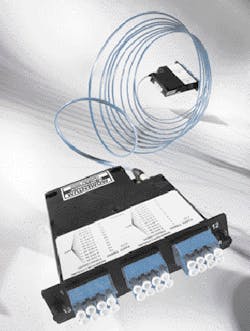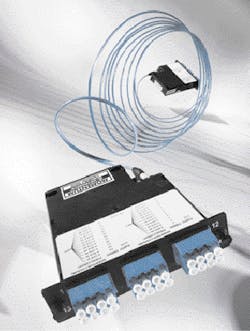Preterminated fiber systems and polarity maintenance
by Rudolph Montgelas
The TIA/EIA-568-B.1-7 specifications define three methods of maintaining polarity in serial duplex optical connections.
Optical communication systems provide a myriad of solutions for the many issues facing today’s communications-network designer. Most notably, the reduced cable diameters and increased connection densities offered by fiber links have proven to be extremely valuable in space-constrained installations, such as data centers, large enterprise equipment rooms, central offices, sub-floor spaces, and cable pathways. Fiber-optic cables significantly reduce congestion, making it easier to organize equipment cable runs, as well as improving vital cooling airflow for servers and supporting equipment.
Because a typical fiber-optic link requires two fibers for full-duplex (two-way) communications, you need to be sure the optical transceivers are connected properly at each end. Specifically, the transmitter’s optical light source (either a laser or light-emitting diode [LED]) at one end of the link must be connected to the corresponding photo detector of the receiver at the other end.
The task of ensuring that the transmitter is properly connected to the receiver is easier when the link involves only one fiber; however, when the link contains two or more fibers, the situation is more complex. Bidirectional transmission, multiple connections, and splices along the link further complicate the system design.
Modular fiber system advantages
Modular preterminated fiber-optic cabling systems are particularly useful in data center applications due to the high connection densities, superior optical performance of a factory-terminated connection, and the simplicity of a modular installation. These systems provide such advantages as reductions in: labor costs, congestion in cable pathways and spaces, on-site installation time, and security risk. Additional advantages include increases in optical port density, component modularity, optical performance-and-reliability, and system interoperability.
Preterminated fiber MTP/MPO optical cassettes and loose-tube or ribbon fiber backbone cables are the heart of a modular fiber system. The cassettes and cables typically support groups of full-duplex fiber connections. The challenge for the network system designer becomes one of assuring the proper polarity of these array connections from end to end.
Methods defined in a TIA/EIA standard assure correct polarity using MPO multifiber array connectors, cables, and cassettes. This article describes those methods and examines the advantages and disadvantages of the approved methods.
Standards and methods
The TR-42.8 Technical Engineering Subcommittee has developed a standard that addresses the polarity issues associated with multi-fiber array connections. (This document, TIA-568-B.1-7, is available through the Internet for purchase as a reference document.)
Currently, a new release of the TIA-568 Commercial Building Cabling Standard is under development as the TIA-568-C series of standards. The fiber-systems section of this series will be TIA-568-C.1, and will include information on array system polarity along with a description of MPO array cables, duplex patch cords, and array transitions.
TIA-568-B.1-7 outlines two types of fiber links: serial duplex pair connections and parallel optical connections. Currently, parallel optical systems are not commonly deployed, so the scope of this article will be limited to discussing the impact of polarity as it pertains to serial duplex pair connections.
The TIA standard currently lists three connectivity methods for wiring point-to-point fiber links using array connections. The three methods are designed to assure correct transceiver polarity. They assume one is working with a set of common patch cord, array cable, and transition (fanout harness) components.
Proper connectivity of these system components is crucial for correct link operation. The TIA standard does not promote one method as a better choice than another. The standard does, however, require consistency to ensure correct operation. In other words, once you choose a particular connectivity method, you should use it throughout the installation.
To maintain system compatibility and interoperability, your selected cabling scheme should also adhere to one of the methods in the standard. Selecting a proprietary connection method falling outside the definitions in the standard could result in a potential sole-sourcing situation.
Patch cords and keyed connectors
TIA-568-B.1-7 defines a set of common components used to complete an end-to-end fiber duplex pair connection. At one end of the cable plant, patch cords connect terminal equipment to patch panels. At the other end, patch cords connect workstation outlets to the end-user’s equipment.
Two types of duplex patch cords are defined within the TIA standard: A-to-A type and A-to-B type. They are commonly constructed from a figure-8 cross-section duplex zipcord-type cable. Patch cords made with individual single fiber connectors at each end allow the flexibility for connections to be “swapped” when a polarity reversal is required. They also eliminate the need for a facility to stock both A-to-B and A-to-A style patch cords. Patch cords manufactured with molded duplex connectors at each end do not provide this flexibility.
Fiber-optic connectors are typically “keyed” to maintain a repeatable position when they are mated to other connectors, or to laser or LED receptacles mounted in active equipment. This keying is to assure consistent optical transmission performance. Multifiber connectors also have keys to maintain proper polarity. In the case of angle-polished connectors, the keys also serve to assure that the factory polished angles, at the ferrule tip, will align properly when the connectors are mated together.
The keys on a multifiber array connector, such as an MPO, fit into keyed adapters for proper polarity, as well as for repeatable optical performance and angle-polished intermateability.
Modular fiber cassettes-enclosed units containing 12- or 24-fiber factory-terminated fanouts-serve to transition small-diameter ribbon cables terminated with an MPO connector to the more-common LC or SC interfaces used on the transceiver terminal equipment. The fanouts typically incorporate SC, LC, ST-style or MT-RJ connectors plugged into adapters on the cassette’s front, and an MPO connector plugged into an MPO adapter on the cassette’s rear side.
One or more MPO fanout assemblies may be installed inside the cassette to connect up to two, 12-fiber ribbon cables, for a total of 24 fibers. Alignment pins that are preinstalled in the MPO connector within the cassette precisely align the mating fibers in the MPO connectors at either end of the array cables that plug into the cassettes.
The transition that takes place inside a cassette, the connector keying for the cassette, and the corresponding MPO array cables are all thoroughly defined for all three connectivity methods listed in the TIA standard. A common transition, factory-installed inside a cassette, is used for all three methods. The adapter mounted at the rear of a cassette defines it as either a Method A or Method B type. The only difference between the two cassette types is the orientation of the internal MPO connector with respect to the mating MPO array cable connector.
Method A cassettes make a “key up”-to-“key down” connection between the internal MPO connector and the MPO array cable connector. Method B cassettes make a “key up”-to-“key up” connection. It is important to note that a Method B cassette will not allow singlemode angle-polish mated-pair connection because the angles of the mating connectors are not complementary. This prevents a Method B cassette or adapter from being used in singlemode applications that require low return losses-a significant limitation.
MPO array cables
Modular fiber cassettes are connected to one another with MPO-to-MPO ribbon backbone cables. The connectors on these cables do not contain alignment pins, but they do have mating alignment holes. Alignment pins are factory-installed in the MPO fanout connectors installed inside the cassette.
The TIA standard defines three different 12-fiber MPO-to-MPO ribbon backbone cables: Types A, B, and C. Each is used for its respective connectivity method (Methods A, B, and C).
For the Type A array cable, the opposing connections at each end of the cable have the same fiber positions, except that one end has the key oriented facing up while the other end has the key oriented facing down.
The Type B array cable has opposing connectors with both keys oriented facing up, but the fiber positions are reversed at each end; the fiber at position 1 at one end is connected to position 12 in the connector at the opposing end.
In the Type C array cable, the key is facing up at one end and facing down at the other end. It looks like a Type-A array cable, but the Type-C cable is designed such that adjacent pairs of fibers are crossed from one end to the other. In this case, the fiber at position 1 on one end of the cable is shifted to position 2 at the other end of the cable. The fiber at position 2 on one end is shifted to position 1 at the opposite end, and so on.
Connectivity methods
The patch cords, cassettes (transitions) and array cables previously described are used in specific combinations to form end-to-end full-duplex fiber links. Each component of the total fiber cabling system is unique, underscoring the importance of assuring that the correct component is selected and used in the proper sequence.
Importantly, regardless of which method defined in the TIA standard you use, there must be a pair-wise flipping (A-to-B polarity swap) that takes place at some point in the link. If the pair-wise flipping does not occur in the cassette (transition), then the pair-wise flipping must occur in the duplex patch cord, or in the MPO-to-MPO array cables and/or adapters.
Modular cassette-based cabling technology offers many advantages facilitating high-performance, rapid, and error-free installation, as well as reliable, robust operation. The best way to maintain correct optical polarity in these systems is to select a standards-based approach and to adhere to it throughout an installation. The three connectivity methods defined in the TIA/EIA-56-B.1-7 standard present the guidelines for maintaining polarity using array connections.
Compatibility concerns
It is in the best interest of the installer and end-user to select modular optical fiber-cassette-based solutions that adhere to TIA standards. Proprietary non-standards-based solutions will not assure interoperability. In addition, those solutions may not be compatible with commercially based components designed to meet the TIA standards. Selecting modular fiber systems that comply with TIA standards can help to prevent costly troubleshooting and rework of the installed fiber cable plant. Additionally, fiber-network installers can be assured of a readily available product supply from multiple stocking supply sources with acceptable delivery lead times.
It is also very important for the installer, contractor, system architect, and end user to understand the implications of connecting a particular component into a full-duplex fiber link. Incorrect connections that violate the proper polarity will result in a link failure and possibly damage critical optoelectronic components. Normal network operation could be significantly delayed as a result.
That is why it is important to know which standardized connectivity method has been specified for a particular modular fiber installation.RUDOLPH MONTGELAS is fiber-optic senior product manager with Ortronics/Legrand (www.ortronics.com).

